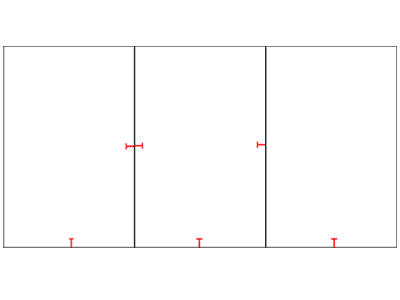Boundary Disputes
- Most property in England and Wales has no exact boundary. Even the official title plans held by the Land Registry are noted as 'general boundaries' only.
- There is usually no record of who is responsible for the boundary fence, hedge or wall (unless your title deeds show 'T' or 'H' labels).
- Because of this ambiguity, boundary disputes are common, but they can be resolved and prevented with a determined boundary.
- You can also apply to have the title plan corrected if you believe there is a mistake.
- 1
What is a boundary dispute?
Boundary disputes arise when neighbours disagree over where exactly one person's property ends and the other's begins. With fences being moved or replaced, or hedge rows growing wider, many homeowners fear losing part of their land through Adverse Possession.
Examples of boundary issues
- Neighbour one builds an extension which comes too close to or crosses the perceived boundary line;
- Neighbour one fails to maintain a wall which neighbour two believes they are responsible for;
- Neighbour one removes a hedge, wall or fence, which neighbour two believes is theirs;
- Neighbour one removes a partition wall, fence or hedge and fails to replace it;
- Neighbour one replaces a boundary in a different position;
- Neighbour one cuts down a tree on the boundary which neighbour two claims is theirs;
- Neighbour one fails to trim or prune a hedge which is encroaching onto neighbour two's property;
- Neighbour one 'temporarily' leaves items such as building materials on neighbour two's property or on a shared access driveway and leaves them there.
What does boundary mean?
In land ownership, the word 'boundary' is understood in two ways:
- a
Physical boundaries are features or structures such as walls, fences and hedges, ditches or edges (of a driveway or patio, for example). These are almost never recorded on the title paperwork (unless there was a previous, successful application for a determined boundary). However, the Land Registry may have kept relevant files, such as a copy of a deed that refers to a boundary declaration or agreement or to the ownership or maintenance of boundaries.
- b
A legal boundary is a precise invisible line dividing the land owned by one person from another’s. It does not have thickness or width and usually, but not always, falls somewhere in or along a physical boundary feature such as a wall, fence or hedge. The exact positions of the legal boundaries are almost never shown on registered title plans, which can lead to a boundary dispute.
If you have a 'T' marked in your deed plan with the base on the boundary and the crossbar inside your property, then you are responsible for it; if the crossbar of the T falls in the neighbour's property, they are responsible for it. Party walls are often marked with an 'H', which crosses the boundary, showing both sides share responsibility for the boundary.

Where both parties are responsible, there will often be a dispute over what to do about a boundary. For example, neighbour one is in their 'forever home' and wants to replace a broken boundary fence with a long-lasting wall, the costs of which will be split two ways. Neighbour two is selling their house soon and only wants to replace the fence, as it was, for a lower shared cost.
- 2
How do you prove a boundary line?
The Land Registry title plan is generated using Ordnance Survey maps and the data held at the Land Registry. The red edging on a title plan is not definitive evidence of precise boundary lines and shows the general boundary of your property in relation to other physical features on the ground, such as hedges, trees or walls.
Official copies carry the following warning:
'This title plan shows the general position of the boundaries: it does not show the exact line of the boundaries. Measurements scaled from this plan may not match measurements between the same points on the ground'.
How do you check your boundary before you buy the property?
You can use the Title Plan as a guide to gauge your boundary. Although it isn't exact, it can be used in comparison with the physical boundary to identify any material changes. The seller is legally obligated to inform you if they have a pre-existing boundary dispute with a neighbour in the TA6 form.
The truth is that it is very difficult to prove your legal boundary unless you employ the services of a land surveyor to carry out a physical assessment and use old title plans (if available) to try and identify the legal boundary of a property. This needs to be done by the current owner.
- 3
Boundary disputes between neighbours are very common. Before raising an issue, you should get as much information together as possible such as:
- Official Copy of the Register of Title Including Plan for both yours and your neighbours titles. Get your title plan information from Land Registry Online (only available for registered titles)
- Original Title Deeds - these may contain additional information about your legal boundary compared to the Official Copy of the Register of Title.
- Registration documents - from when you purchased the property.
- Boundary Survey - to evidence your legal boundary.
What are examples of boundary violations?
Changes to boundary
Such as over growing hedges or the changing of a hedge to a fence (or vice versa). You should seek the consent with your neighbour before making any changes to your boundary.
Extensions to property
Such as building too close, or over your neighbours boundary. You should provide plans to your neighbour of what you are planning to build. Your neighbour may not be happy with your planned works, however you can still get their acceptance where you are planning to build.
What happens if you have no boundary feature?
If your property doesn't have a hedge or a fence then you should speak to your neighbour before erecting a fence. Putting up a physical boundary without your next door neighbours consent is more than likely going to lead to a dispute over your legal boundary. Read on to find out what you should do.
- 4
What can I do if my Neighbour disputes boundary?
Working on an amicable solution is critical as the legal costs can go into the thousands, and the damage to your relationship with your neighbour might be irreparable. You can address the dispute by either drawing up a Boundary Agreement, or if this can't be agreed you can apply to get a Determined Boundary.
Boundary Agreement
A boundary agreement may be appropriate where neighbours are in agreement as to the boundary between their properties. The agreement can deal with the position of the legal boundary, or the maintenance of a boundary feature (such as a hedge), or both.
For example, owners may agree that the legal boundary between their properties is the middle of a hedge (and that each will keep their side of the hedge below a certain height). Or there may be a post and rail fence and a brick wall running close together between two properties and the owners agree which of the two possible boundary features marks the legal boundary.
Example Boundary Agreement
This agreement is made on 15th July 2014 between John Smith of 112 Juniper Avenue title to which is registered under title number XX12345 and Mary Duggan of 111 Juniper Avenue, London title to which is registered under title number XX67891.
The parties agree that the legal boundary between the land within their respective registered titles and running from the point marked ‘A’ to the point marked ‘B’ on the plan attached is as shown by the red line drawn between those points.
Signed by Land Owner
[Witness (Signature, name and address)]
Signed by Neighbouring Land Owner
[Witness (Signature, name and address)]
Once the Boundary Agreement is signed and witnessed, both you and your neighbour can register it against their title at the Land Registry (meaning it'll be easily available if in the future there are any further boundary disputes). To register the Boundary Agreement you'll need to complete a AP1 form and pay the registration fee.
Determined Boundary
A Determined Boundary shows the exact line of the boundary of a registered estate, although The Act does not define exact. A determined boundary plan should be created by a qualified land surveyor who has adequate skill and training. The surveyor will need evidence of both titles, original deeds and even aerial photos of the two titles.
The Land Surveyor uses this information to provide their opinion of where the legal boundary is for your title. A surveyor will normally survey the boundary to be determined in one of two ways:
- aby the use of measurements from permanent features; or
- bby the use of Ordnance Survey National Grid coordinates. This would normally only be appropriate in remote areas, where there is little in the way of suitable permanent features, or where taped measurements would be excessively long. Using coordinates requires specialist surveying equipment and will likely be the more expensive option.
Our property boundary survey cost starts from £995 Exc VAT.
Included in our Fixed Fee:
- Production of accurate topographical site survey plans.
- Evaluation of available boundary documentation and mapping.
- Digital overlay of boundary mapping onto topographical plan.
- Boundary reports compatible with Civil Procedure Rules part 35 (CPR35).
- RICS Registered Expert Witness for court proceedings.

To register your Determined Boundary at the Land Registry you'll need to complete a DB from. The form requires you to provide information of all adjoining owners (freehold legal owners) and any supporting evidence, such as your land survey. You'll also need to send payment for the cost of registering the Determined Boundary.
The Land Registry will contact the adjoining owners following receipt of your DB form to seek their approval to your Determined Boundary. If your neighbours dispute your application, then the Land Registry will refer the dispute to the First-Tier Tribunal (Property Chamber - Land Registration). The tribunal will make a decision on what should happen and you could have to turn up to a hearing.
Andrew started his career in 2000 working within conveyancing solicitor firms and grew hands-on knowledge of a wide variety of conveyancing challenges and solutions. After helping in excess of 50,000 clients in his career, he uses all this experience within his article writing for SAM, mainstream media and his self published book How to Buy a House Without Killing Anyone.
Caragh is an excellent writer and copy editor of books, news articles and editorials. She has written extensively for SAM for a variety of conveyancing, survey, property law and mortgage-related articles.









